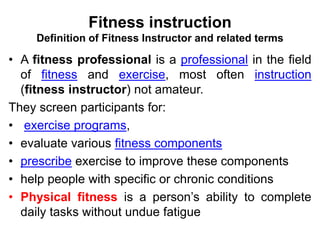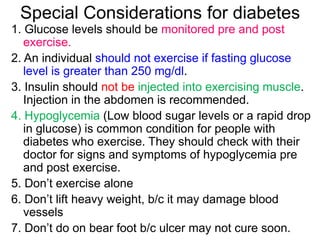This document provides information on fitness instructors and their role in developing individualized training programs. It discusses the key components of being a fitness instructor including evaluating participants' fitness levels, prescribing appropriate exercises, and monitoring progress. It also outlines the 6-stage process for creating a customized training plan, which involves gathering client details, assessing fitness components, conducting tests, analyzing gaps, designing the program, and monitoring results. The document emphasizes the importance of fitness instructors having proper certifications and adapting programs for clients' abilities and health goals.







































































![To apply this method you have to follow the
following steps.
Step 1: calculate your Basal Metabolic Rate by
applying gender related formula
• There are 2 formulae used to calculate BMR, in [kcal
/ 24hrs] for men and women respectively:
1. BMR for Men = 66.47 + (13.7 * weight [kg]) + (5 *
size [cm]) − (6.8 * age [years])
2. BMR for Women = 655.1 + (9.6 * weight [kg]) + (1.8 *
size [cm]) − (4.7 * age [years])
Step 2: calculate your Thermic Effect of Food
• This is equivalent to 10% of your total daily food
intake (it is mandatory to refer daily food record in
table 3.)
Step 3: calculate your Physical activity energy cost
• This is the total energy demand for any physical
activities per a day (refer from energy cost for
physical activity in table below)](https://image.slidesharecdn.com/m3w6mv7rrt2v2vugytlg-fitness-ellective-teaching-220812220027-aaf694e0/85/Fitness_ellective_teaching-pptx-72-320.jpg)















